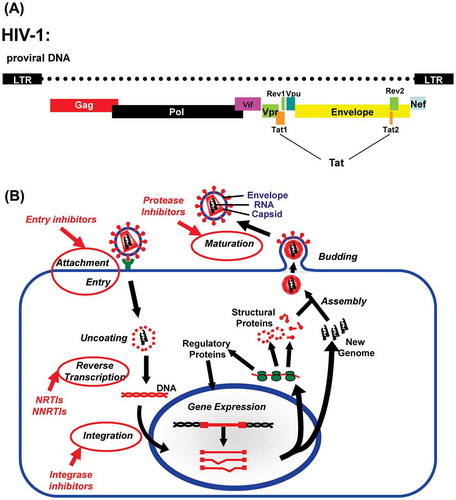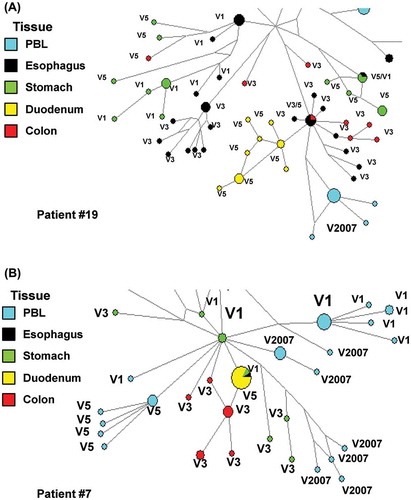Figures & data
Figure 1. (A) Schematic representation of the HIV-1 viral genome organization in its proviral DNA form: The long terminal repearts (LTR) act as promoter and poly-adenylation sites for the production of the full length viral genomic RNA transcript, that is ultimately incorporated in the virus particle. The gag and pol proteins are translated from the full length genomic RNA. The other viral proteins (Env,Tat, Vpu, Vif, Vpr, Rev, and Nef) are translated from mRNAs generated from the genomic RNA transcript by differential splicing. (B) Schematic representation of the HIV life cycle: HIV is an enveloped virus and upon binding to the cell, the HIV viral membrane will fuse with the cell, which allows the viral capsid to enter. The viral RNA is reverse transcribed into the proviral cDNA by the viral reverse transcriptase (RT). Subsequently, the viral integrase (IN) integrates the proviral cDNA intro the host genome. The host transcription machinery transcribes the proviral cDNA and produces various mRNAs encoding for the different HIV proteins, as well as the full length viral genomic RNA. The virus assembles at the cell surface membrane. After budding, the viral protease, mediates a proteolytic cleavage of the viral capsid, resulting in the mature infectious virus particle (virion). The currently available antiretroviral drugs target different steps in the life cycle. The steps at which the different drugs (Entry/Attachment, NRTIs, NNRTIs, Integrase, and protease inhibitors) act are indicated with circles and arrows.

Figure 2. Network analyses of RT encoding proviral DNA sequences from gut and peripheral blood lymphocytes (PBL) from different visits (V). Patient #19 (A) patient #7 (B) viral sequence found in PBL in 2007 (patient on cART, V2007) where closely related to pre cART (V1–V7) sequences of different tissues. There does not appear to be one specific tissue of origin. These observations suggest highly dynamic and complex viral dynamics between the gut viral reservoirs and peripheral blood (van der Meer & van Marle (unpublished results)).

